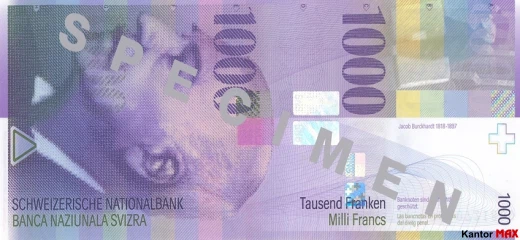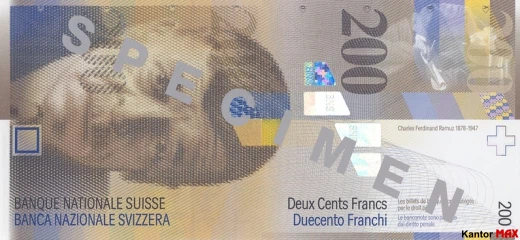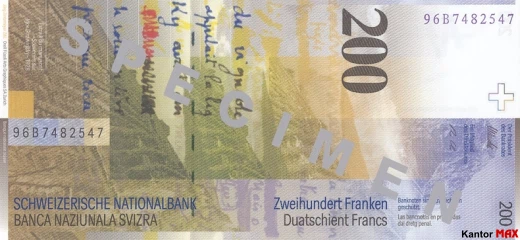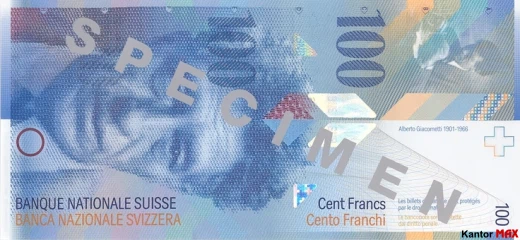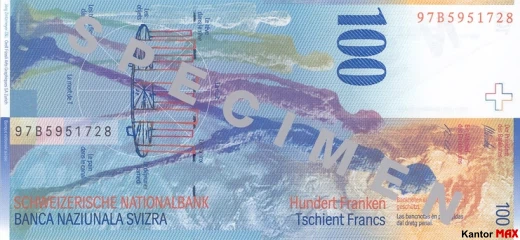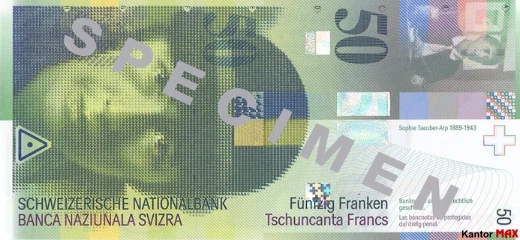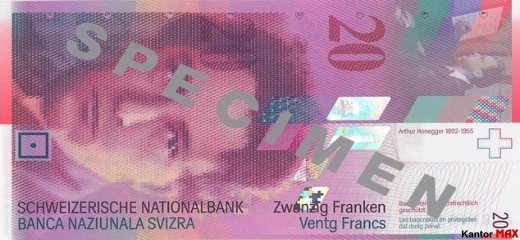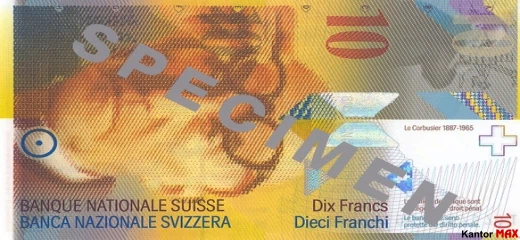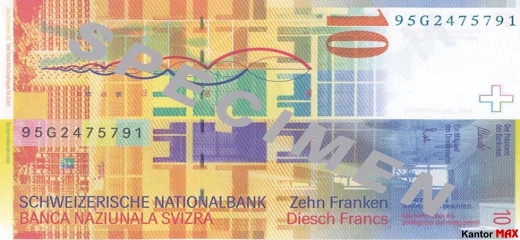| kiedy hurt ? | kupno | sprzedaż |
|---|---|---|
|
Swiss francs 8th series
Swiss francs 8th series
|
4.3636 | 4.5510 |
|
Swiss francs 8th series
Swiss francs 8th series
|
4.1684 | 4.5602 |
At the Grand currency exchange office in Katowice, we have been purchasing the five banknotes presented below since the beginning of May. These are banknotes withdrawn from the 8th series of the Swiss franc, which according to the information provided by the Swiss National Bank, ceased to be legal tender as of April 30, 2021. So, in practice, you cannot pay with them in Switzerland, the only option is to exchange your banknotes locally in Switzerland.
If you have banknotes of this series, please contact our currency cashiers, our branch is located in the center of Katowice at ul. Mickiewicza. Please note that there are two wholesale and retail prices - the wholesale price is set by the employee, but it is assumed that it is valid from the transaction value of PLN 7,000.
Withdrawn Swiss francs have a fixed value, i.e. the value of the banknote does not change. Exchange is also possible indefinitely, but it is worth noting that not all banks are obliged to purchase them. According to the SNB, banknotes will continue to be accepted at SBB or post office counters until October 2021. Traveling to Switzerland to exchange withdrawn banknotes is in most cases unprofitable and also a waste of time. Our company purchases any amount of Swiss franc, and the price is attractive - for more information, call the Grand currency exchange office in Katowice.
The eighth series of Swiss franc banknotes, designed by Jörg Zintzmeyer, entered circulation in 1995.
10 CHF : the portrait on the obverse of the 10 franc banknote depicts Charles Edouard Jeanneret, better known as Le Corbusier (1887-1965), one of the leading masters of modern design. He was an architect, urban planner, painter and theoretician whose creative energy focused on man. This orientation is expressed primarily in pioneering concepts of housing design and urban planning. He used prefabrication and frame construction techniques in an innovative, industrial approach to construction, such as the government complex in Chandigarh, India. Moreover, he influenced modern design and gained international recognition as a furniture designer and architect of religious buildings, e.g. the famous pilgrimage church of Notre-Dame-du-Haut in Ronchamp, France.
20 CHF : the portrait on the obverse of the 20 franc banknote depicts Arthur Honegger (1892-1955), one of the greatest composers of the 20th century. The rich oeuvre of this Swiss composer includes two operas, five symphonies, several orchestral works, several dramatic oratorios and a wide corpus of chamber music. In addition to the famous Symphony for the Steam Locomotive Pacific 231 (elements on the back of the banknote refer to this work), Honegger wrote extensively in a lighter tone for ballet, theater and film. The strict formalism and clarity of his musical language, with which he hoped to reach a very wide audience, is an important bridge between German and Francophone culture.
50 CHF : the portrait on the obverse of the 50 franc banknote depicts Sophie Taeuber-Arp (1889-1943), one of the most outstanding abstract artists of the 20th century. Her work includes paintings, textiles, sculptures and bas-reliefs. Dance and theater were also among the artists favorite means of expression. Her work is characterized by round, linear and rectangular compositions, as well as the famous Dada Heads, which can be seen on the reverse of the banknote. Sophie Taeuber-Arp, who was at the forefront of new artistic movements, is one of the key figures of contemporary art.
100 CHF : the portrait on the obverse of the 100 franc banknote depicts Alberto Giacometti (1901-1966), one of the most important sculptors of the 20th century. Giacometti became famous in the 1930s for his surrealist-style sculptural works. But it was his later works that brought him his greatest fame. Giacomettis distinctive style first appeared in 1946: attenuated figures that appear almost weightless and massless. The female figures are visible from the front, with their feet together, their arms pressed to their sides and their feet in the form of knobs. Males usually walk in large strides. The characters seem lonely and distant. In his work, he tried to capture the complexity and reality of experiences. This can also be seen in his painting, very expressive and devoid of any illusions.
200 CHF : the portrait on the obverse of the 200 franc banknote depicts Charles Ferdinand Ramuz (1878-1947), one of the leading French-speaking Swiss writers of the 20th century. His extensive literary output includes novels, essays, poetry, theoretical writings, and treatises on the music of Igor Stravinsky. Ramuzs work is characterized by a deep attachment to truth and strict aesthetic standards. At the center of his writings are people with all their hopes and wishes. Perfectly rendered landscapes constitute a background on which a special place is placed include mountain regions and lakes. In formal terms, Ramuz modernized the novel, using new expressive techniques borrowed from painting and film.
1000 CHF : the portrait on the obverse of the 1000 franc banknote depicts Jacob Burckhardt (1818-1897), one of the most outstanding German-speaking cultural historians of the 19th century. It is famous primarily for its grounded and artistically sensitive interpretation of the Italian Renaissance and for its guide to the artistic treasures of Italy, a work that has become a classic. Burckhardts works form the basis of the modern scientific study of art history. Even today, his concept of the Renaissance shapes our understanding of the modern era. As a historian, Jacob Burckhardt applied his literary skills to historiography, and his work is considered a classic of academic prose. In particular, he described the main currents in comparable periods that remained constant over time. Instead of presenting a linear description of the story,
Awers Old 1000 Swiss Francs
Rewers Old 1000 Swiss Francs
Awers Old 200 Swiss francs
Rewers Old 200 Swiss francs
Awers Old 100 Swiss Francs
Rewers Old 100 Swiss Francs
Awers Old 50 Swiss Francs
Rewers Old 50 Swiss Francs
Awers Old 20 Swiss Francs
Rewers Old 20 Swiss Francs
Awers Old 10 Swiss Francs
Rewers Old 10 Swiss Francs
